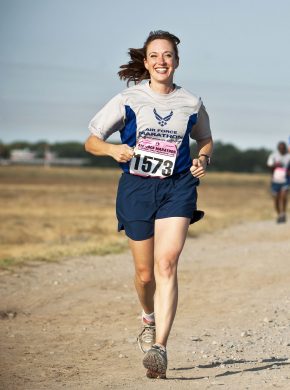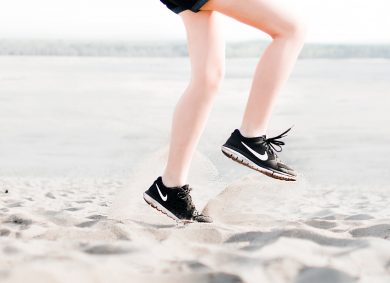
Gruffalo or effortless runner What type of runner are you?
With the festive season upon us, we prepare for those lovely moments with family and friends. You may be flying out to meet loved ones and spend precious moments with those who matter most to you. You may in a position to entertain guests coming here to Thailand and you will undoubtedly show them the best of what the Kingdom has to offer. Celebrating Christmas, we laugh, dance, sing, catch up, reflect and look ahead with the best wine-and-dines we can think of. The festive season really is the time to indulge and make the most of those precious moments together.
 I am sure lots of amazing, mouthwatering meals are already being carefully crafted in our imagination and complemented with an equally impressive array of wine and spirits. And with the New Year arriving fast, we also make a short list of resolutions. One of those may be to enter that running event your colleagues talk about. If that is the case, you may want to start with analysing what type of runner you are. If you intend to make running part of your life, start by reviewing which one of the four types of runners you most resemble. “Knowing what your run looks like and how to improve that form, will go a long way in running in a more effortless manner and preventing injury over time.” Much like a fingerprint, you have your own distinct way of running that suits your body best. But there are common mistakes that many of us make that are easy to avoid and have a great influence on your form and your perceived effort in running.
I am sure lots of amazing, mouthwatering meals are already being carefully crafted in our imagination and complemented with an equally impressive array of wine and spirits. And with the New Year arriving fast, we also make a short list of resolutions. One of those may be to enter that running event your colleagues talk about. If that is the case, you may want to start with analysing what type of runner you are. If you intend to make running part of your life, start by reviewing which one of the four types of runners you most resemble. “Knowing what your run looks like and how to improve that form, will go a long way in running in a more effortless manner and preventing injury over time.” Much like a fingerprint, you have your own distinct way of running that suits your body best. But there are common mistakes that many of us make that are easy to avoid and have a great influence on your form and your perceived effort in running.
A. The Reacher
 The Reacher wants to get this run over-and-done with. “How do I get home as quickly as possible? I know, I’ll just take bigger steps to get there faster!” Over-striding or reaching in your stride is an interesting phenomenon that is very much a mental override from your natural gait efficiency. The Reacher has at some point decided that logic dictates that bigger strides get the job done quicker. Lengthening your stride is not a bad idea per se. But lengthening your stride and not pulling your leg back underneath your centre of mass is a recipe for disaster. Reachers are almost all so-called heel strikers as you can see in the image above. The Reacher’s leg is in a fully extended position, leaving no room for shock absorption of the ground reaction force other than in the hip. Comments like: “I am 35 years old, why does it feel like I need a hip replacement every time I finish a run” often have their origin in over-striding or reaching in your stride.
The Reacher wants to get this run over-and-done with. “How do I get home as quickly as possible? I know, I’ll just take bigger steps to get there faster!” Over-striding or reaching in your stride is an interesting phenomenon that is very much a mental override from your natural gait efficiency. The Reacher has at some point decided that logic dictates that bigger strides get the job done quicker. Lengthening your stride is not a bad idea per se. But lengthening your stride and not pulling your leg back underneath your centre of mass is a recipe for disaster. Reachers are almost all so-called heel strikers as you can see in the image above. The Reacher’s leg is in a fully extended position, leaving no room for shock absorption of the ground reaction force other than in the hip. Comments like: “I am 35 years old, why does it feel like I need a hip replacement every time I finish a run” often have their origin in over-striding or reaching in your stride.
Are you a get-this-over-and-done-with type of runner? Then you may want to start swinging your foot back underneath your centre of mass. Paradoxically, by placing their feet out in front of their centre of mass, the Reacher is effectively putting on the brakes every time s/he makes a stride. That of course slows you down rather than brings you home faster. By placing the foot too far out in front, the Reacher has to then bring the body over the anchor point in that stride, requiring a lot of energy, and so develops a ‘stop-starting-motion’ with every single step.
B. The Gruffalo
 You feel the ground vibrating, a shadow is cast forward, you hear the thumping behind you getting louder and louder, heavy breathing noises arise from what lurks behind you… The Gruffalo runner is a loud, noisy runner whose foot-strike is heavy and creates a lot of impact on the runner’s body. The heavy foot-strike is usually complemented with a lot of excess body movement in the upper body. This runner over-rotates, runs with elbows out and has a bobbing head throughout the gait cycle. A Gruffalo runner isn’t necessarily a big person, a petit runner can also create a big noise. As you run, you have to accommodate up to 3 times your body weight when you land. This can make even a lightweight runner sound like a heavy duty freight train when running.
You feel the ground vibrating, a shadow is cast forward, you hear the thumping behind you getting louder and louder, heavy breathing noises arise from what lurks behind you… The Gruffalo runner is a loud, noisy runner whose foot-strike is heavy and creates a lot of impact on the runner’s body. The heavy foot-strike is usually complemented with a lot of excess body movement in the upper body. This runner over-rotates, runs with elbows out and has a bobbing head throughout the gait cycle. A Gruffalo runner isn’t necessarily a big person, a petit runner can also create a big noise. As you run, you have to accommodate up to 3 times your body weight when you land. This can make even a lightweight runner sound like a heavy duty freight train when running.
Gruffalo runners are especially at risk of knee and hip injuries as more often than not, those joints have to absorb the impact of the constant pounding. They usually run on shoes with the biggest cushion you can find. Marshmallow shoes, I call them. The jarring motion that they subject their bodies too often leaves the Gruffalo runner with a headache after the run. I know I would have one if I pounded the pavement like a Gruffalo runner does. Does this sound (pun intended) like you? Then what you might want to look into is doing some activation drills before your run. Boxers are typically very light on their feet. Float like a butterfly… not like a Gruffelo. Before your run, grab a jump rope and see if you can skip like Muhammad Ali in his heyday.
C. The Shuffler
 Cliff Young, the Australian ultra runner, famous for using a shuffle run knew this way of running would keep him going. The Shuffler is smart. S/he knows there is a long way to go and that wasting energy is silly. ‘Conserve your energy to last you all the way through your run’ is their motto. Not a bad idea but in reducing your run to a shuffle, you are not actually running in the biomechanical sense anymore. The Shuffler takes the running motion and reduces it to something much more like jogging. In a jog, there is little need to pull your ankle and knee up in order to make space for the down-sweep of the leg. The shuffler can get by, using a pendulum swing of the lower leg. Energy efficient for sure but you are not actually running and therefore limit yourself in speed.
Cliff Young, the Australian ultra runner, famous for using a shuffle run knew this way of running would keep him going. The Shuffler is smart. S/he knows there is a long way to go and that wasting energy is silly. ‘Conserve your energy to last you all the way through your run’ is their motto. Not a bad idea but in reducing your run to a shuffle, you are not actually running in the biomechanical sense anymore. The Shuffler takes the running motion and reduces it to something much more like jogging. In a jog, there is little need to pull your ankle and knee up in order to make space for the down-sweep of the leg. The shuffler can get by, using a pendulum swing of the lower leg. Energy efficient for sure but you are not actually running and therefore limit yourself in speed.
As distances get longer, the percentage of Shufflers grows. This isn’t a good or bad thing, as you need to make sure you work at an effort that allows you to finish the race. If you feel that you are more efficient in your jogging-like shuffle style, you can keep doing that for the race. However, it shouldn’t be your default as you have a better, more energy efficient gait at your disposal for the moments you want to go faster. Shufflers should aim to ‘pull their ankle up’ as shown in the image. That way, you drive your knee forward and avoid the shuffle where knees stay together so close you gift wrap them and the runner would not notice.
D. The Bouncer
 Not the one you see at the entrance of the club but more like a stotting deer or a gazelle. The Bouncer has an unusually high vertical oscillation (up-and-down motion) in his or her stride. This leads to a lot of energy being drained away from moving forward. It is like running on an incline having to lift yourself up higher and higher with every step or bounce you take. Any excess energy that is not used towards forward motion, is energy wasted that you could have used to move forward faster. In this regard, the Bouncer and the Shuffler are each other’s polar opposites. The Shuffler refuses to activate hip flexors in an attempt to save energy, the Bouncer has energy to burn and uses far too much energy in the vertical direction not helping them to move forward at all. Bouncers are at risk of developing tendon and muscle injuries because of their excessive vertical movement. Bouncers tend to be prone to Achilles tendon issues, shin splints and plantar fasciitis issues.
Not the one you see at the entrance of the club but more like a stotting deer or a gazelle. The Bouncer has an unusually high vertical oscillation (up-and-down motion) in his or her stride. This leads to a lot of energy being drained away from moving forward. It is like running on an incline having to lift yourself up higher and higher with every step or bounce you take. Any excess energy that is not used towards forward motion, is energy wasted that you could have used to move forward faster. In this regard, the Bouncer and the Shuffler are each other’s polar opposites. The Shuffler refuses to activate hip flexors in an attempt to save energy, the Bouncer has energy to burn and uses far too much energy in the vertical direction not helping them to move forward at all. Bouncers are at risk of developing tendon and muscle injuries because of their excessive vertical movement. Bouncers tend to be prone to Achilles tendon issues, shin splints and plantar fasciitis issues.
You can recognise a Bouncer with a ponytail quite easily. Excessive ponytail swing can be an indication of poor run economy as it indicates too much vertical and lateral movement. Instead of a small figure 8 movement, the ponytail of a Bouncer swings wildly up and down and sideways. Bouncers also notice that the horizon is never steady during their run. Did you recognise yourself in one of these descriptions? If you did, you have no reason to throw your running shoes away. These mistakes are easily adjustable with a few Effortless Running method drills.

You can download the free Effortless Running Secrets e-book on www.effortlessrunning.com or contact the Effortless Running coaches for a video analysis of your stride.
Effortless Running workshops are offered at the amazing facilities of the Sports and Wellness Resort of Thanyapura in Phuket. Check the availability of the Effortless Running workshops at www.thanyapura.com



